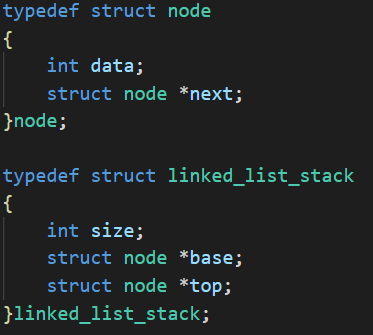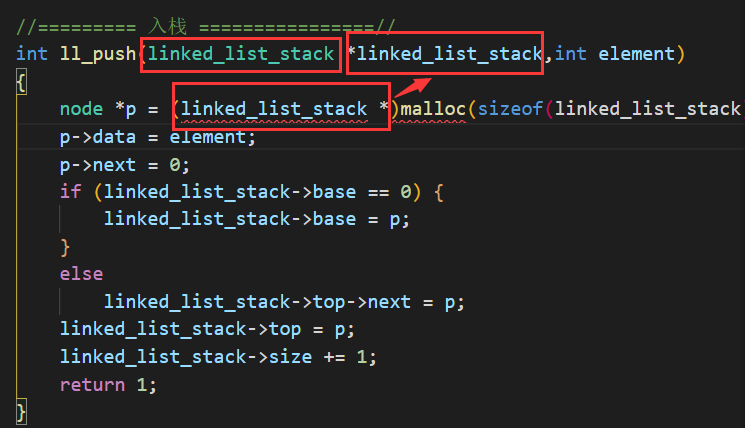Loading... # **栈** ## **括号的匹配** **只用链栈实现** **这部分上数据结构与算法课时也做了实验,当时写得一塌糊涂,过后仔细研究了发现当时没写好两大原因** * **C语言结构定义声明那部分没掌握扎实,以至于第一眼看上去奇怪的很:为啥来了个链表,又来了个栈结构定义,过后发现其实是栈结构里包含了链表结构,跟课本上的不一样,掌握理论还是无用,还得付诸实践学习** **书上的:**  **实际上:**  * **老师给的代码是真有点乱了,结构名变量名一样,导致后面写出的函数混乱不堪,因为菜所以调试了好长时间才发现报错原因**  **可以根据颜色看出来在分配空间时要分配的本应是linked_list_stack的结构空间,结果分配的是形参变量的空间** **后面形参变量改成linked_list_stack1才通过** **所以下回吸取教训,直接大改特改老师的代码** **实验后自己又按着自己的理解想法敲出了可以实现匹配括号的功能** **能够同时匹配()、{}** ### **头部** **命名全部最简化了** ``` #include<stdio.h> #include<malloc.h> #include<string.h> typedef struct node { char data1; // 括号类型 int data2; // 括号位置 struct node *next; } node; typedef struct stack { struct node *top; // 其实base指针没必要了,判断为空一句话就可以了 } stack; ``` ### **函数声明** **只留下了初始化(创建栈)、入栈、出栈的功能** ``` stack *InitStack(void); void Push(stack *S, char e, int n); void Pop(stack *S, char *e, int *n); ``` ### **主函数** **采用while+switch+while来匹配正确括号(主函数有点臃肿)** ``` int main(void) { stack *S = InitStack(); printf("请输入表达式:"); char ch[100]; scanf("%s", ch); int i = 0; char x; int n; while(i < strlen(ch)) { switch(ch[i]) { case '{': case '(': Push(S, ch[i], i); break; case ')': if(S->top != 0) { Pop(S, &x, &n); // 没有按照课本里的 // 如果出现‘{(}’这样的情况不加下面的循环会导致‘(’和最后的‘}’匹配 while(x != '(') // 这里一定要注意要单引号,因为x是字符,卡这里不少时间......开始还想着用strcmp来着,但实际上不行 { Pop(S, &x, &n); } printf("%c %d, %d )\n", x, n + 1, i + 1); // 数值加一,按照正常计数来排列 } break; case '}': if(S->top != 0) { Pop(S, &x, &n); while(x != '{') { Pop(S, &x, &n); } printf("%c %d, %d }\n", x, n + 1, i + 1); } break; } i++; } } ``` ### **初始化** ``` stack *InitStack(void) { stack *S = (stack *)malloc(sizeof(stack)); S->top = 0; return S; } ``` ### **入栈** ``` void Push(stack *S, char e, int n) { node *p = (node *)malloc(sizeof(node)); p->data1 = e; p->data2 = n; p->next = S->top; S->top = p; } ``` ### **出栈** ``` void Pop(stack *S, char *e, int *n) { if(S->top != 0) { node *p = S->top; *e = p->data1; *n = p->data2; p = p->next; free(S->top); S->top = p; } } ``` **实现效果:** **input:......((((((((((....))))))))))...((..(((((((...((((....)))).....)))))))..))(((((((..........((((((.....((((((....)))))).......))))))..))))))).**  **input: {{((())}}{}()..()**  最后修改:2021 年 10 月 25 日 © 允许规范转载 打赏 赞赏作者 支付宝微信 赞 如果觉得我的文章对你有用,请随意赞赏